
It’s a full moon, the Hunter’s Moon and the closest supermoon of 2024.
Super Hunter’s Moon follows the Super Harvest Moon
When and where to look in 2024: For all of us on Earth, the bright, round full moon will rise in the east around sunset on October 17, 2024. It’ll be visible all night. Be sure to watch on the nights before and after that, too. This is the Northern Hemisphere’s Hunter’s Moon, the full moon after the Harvest Moon (which is the full moon closest to the autumnal equinox). This Hunter’s Moon is also the third of four supermoons in a row in 2024.
The crest of the full moon falls that morning for the Americas at 11:26 UTC on October 17. That’s 6:26 a.m. CDT, about two hours before moonset in central North America. If you want to see the fullest possible moon, look in the west on the morning of October 17 before sunrise.
The moon’s perigee, or closest point to Earth for this month, falls about 10 hours before the crest of the moon’s full phase. Perigee comes at 8 p.m. CDT on October 16 (1 UTC on October 17). So this is a very close full moon, known as a supermoon. In fact, it’s the closest supermoon of 2024! So it’ll be the brightest moon of this year.
Characteristics of the Hunter’s Moon: The moon is always roundest on the day that it’s full. And, on the day of a full moon, the moon always rises close to the time of sunset. But the nights before and after a full moon feature a round-looking moon, too. And, like the Harvest Moon, this October Hunter’s moon will be characterized by a shorter-than-usual time between successive moonrises for several nights in a row. So Northern Hemisphere dwellers will see full-looking moons in twilight skies, ascending in the east as the sun sets in the west, for several nights around October 17.
For the Southern Hemisphere, the nights around this full moon feature a longer-than-usual time between successive moonrises. So, for the southern part of the globe, the moon will rise on October 18, 19 and 20 (and for many nights after that) in a sky that’s already dark.
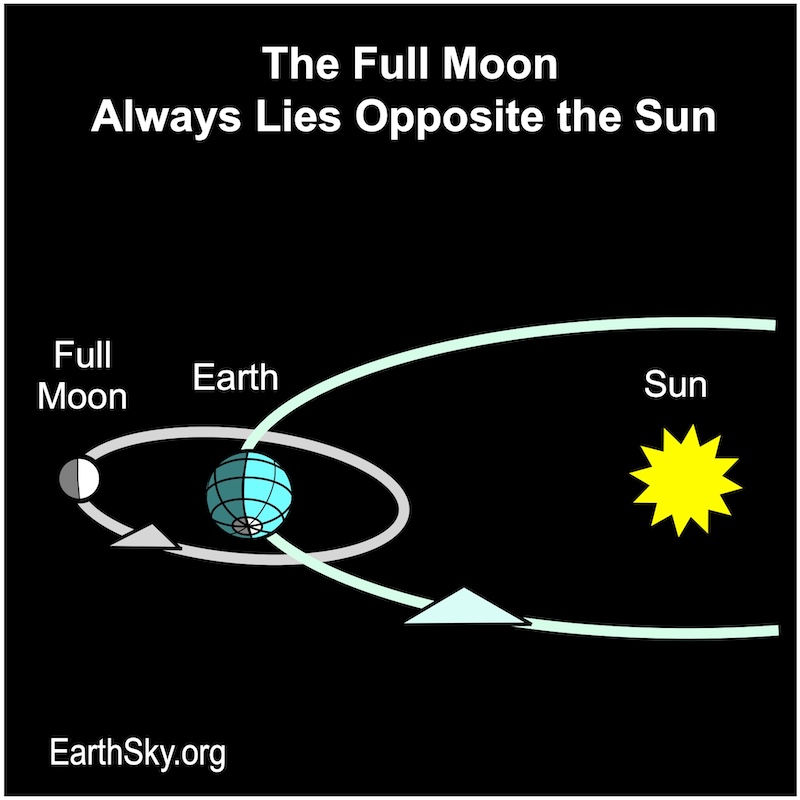
What’s special about a Hunter’s Moon?
A full moon is always opposite the sun in space, and opposite the sun in our sky. So all full moons rise in the east around sunset. And all full moons set in the west around sunrise. But the various full moons have different characteristics.
On average, the moon rises about 50 minutes later each day. But when a full moon happens close to the autumnal equinox – either a Harvest or a Hunter’s Moon – the moon (at mid-temperate latitudes) rises only about 30 to 35 minutes later daily for several days before and after the full moon. The reason is that the ecliptic – which more or less marks the path the moon travels across the sky – makes a narrow angle with the evening horizon around the time of the autumnal equinox.
The result is that there’s a shorter-than-usual lag time between successive moonrises around the full Hunter’s Moon.
Early evening moonrises make every Hunter’s Moon special. Every full moon rises around sunset. After the full Hunter’s Moon, you’ll see the moon ascending in the east relatively soon after sunset for a few days in a row at northerly latitudes.
A great source of moonrise times is the Custom Sunrise Sunset Calendar. Once you get to that page, be sure to click the box for “moon phases” and “moonrise and moonset times.”
By the way, since the Harvest Moon is the closest full moon to the equinox, it can come either before or after it. So the Harvest Moon can sometimes fall in October, which it does every three or four years. When the Harvest Moon falls in October, the Hunter’s Moon – the full moon following the Harvest Moon – will fall in early November.
That’ll happen next in 2025.

A word about supermoons
A full supermoon happens when the full moon happens at – or near – the time the moon is closest to us in its elliptical orbit.
Of course, full supermoons draw a lot of attention and are very popular.
Do supermoons look bigger to the eye? Generally not, unless you’re an avid moon observer. But … do supermoons look brighter than ordinary full moons? Yes! By a noticeable amount. That’s because a supermoon exceeds the disk size of an average-sized moon by up to 8% and the brightness of an average-sized full moon by some 16%. And then, it exceeds the disk size of a micro-moon (a year’s most distant and therefore smallest full moon) up to 14% and the brightness of a micro-moon by some 30%. So, go outside on the night of a full supermoon. Even if you’re a casual observer of the moon, there’s a chance you’ll notice the supermoon is exceptionally bright!
A note to those in the Southern Hemisphere
If you’re in the Southern Hemisphere, your Harvest and Hunter’s Moons center on the March equinox, your autumnal equinox. Much of what we say in his post – the general information about Harvest and Hunter’s Moons – applies to you, too… next March and April.
Right now, your full moon will be doing the opposite of a Hunter’s Moon. That is, for the Southern Hemisphere around the time of the September and October full moons, there’s a longer-than-usual time between moonrises on successive nights.
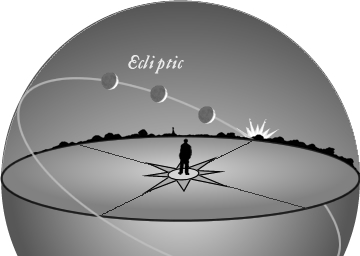
Tips and tricks to view the Super Hunter’s Moon
How did the Hunter’s Moon get its name?
There are many stories surrounding the names of the moons, including the Hunter’s Moon. From a practical standpoint, the Harvest Moon and subsequent Hunter’s Moon provided extra light in the evenings for farmers and hunters to finish their tasks.
Every full moon has a slew of nicknames tied to months of the year. But some moon names, such as the Harvest and Hunter’s Moons, are tied to seasons.
In North America, the Harvest Moon was a time when the bright moon meant farmers could stay out later, working in their fields, gathering in the crops before the first freeze. After the harvest, farmers would turn to hunting deer and other animals to bolster their food stores before winter. The bright light of the full moon and almost full moons would let them hunt into the evening hours. So, we call it a Hunter’s Moon.
Who named the Harvest and Hunter’s Moon? Those names probably sprang to the lips of farmers and hunters throughout the Northern Hemisphere, on autumn evenings, at times of the full moon.
Is a Hunter’s Moon bigger or brighter?
Generally, no. The Hunter’s Moon is just an ordinary full moon with a special path across our sky. Still, many of us do think the Hunter’s Moon looks bigger … or brighter … and more orange than usual. Why?
It’s because the Hunter’s Moon has a powerful mystique. Many people look for it shortly after sunset around the time of full moon. After sunset around any full moon, the moon will always be near the horizon … because full moons rise at sunset. It’s the location of the moon near the horizon that causes the Hunter’s Moon – or any full moon – to look big and orange in color.
The orange color of a moon near the horizon is a true physical effect. It stems from the fact that, when you look toward the horizon, you’re looking through a greater thickness of Earth’s atmosphere than when you gaze up and overhead. The atmosphere scatters blue light – that’s why the sky looks blue. The greater thickness of atmosphere in the direction of a horizon scatters blue light most effectively, but it lets red light pass through to your eyes. So a full moon near the horizon – any full moon near the horizon – takes on a yellow or orange or reddish hue.
The bigger-than-usual size of a moon seen near the horizon is something else entirely. It’s a trick that your eyes are playing – an illusion – called the Moon Illusion.
However, in 2024, the Hunter’s Moon is a supermoon. And it’s the closest supermoon in 2024. So yes, it will look brighter than an average full moon!
2024 full moon is in Pisces
The October full moon usually lies in front of one of three constellations of the zodiac: Pisces the Fish, Aries the Ram, or Cetus the Whale.
Typically, it’s in Pisces and that is the case for 2024.
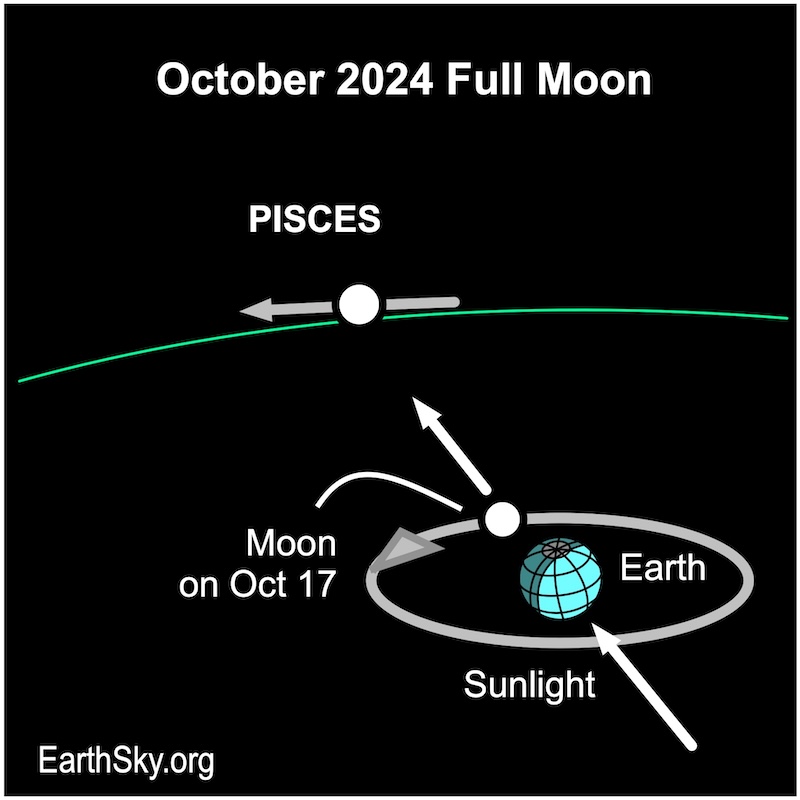
Hunter’s Moon photos from our community
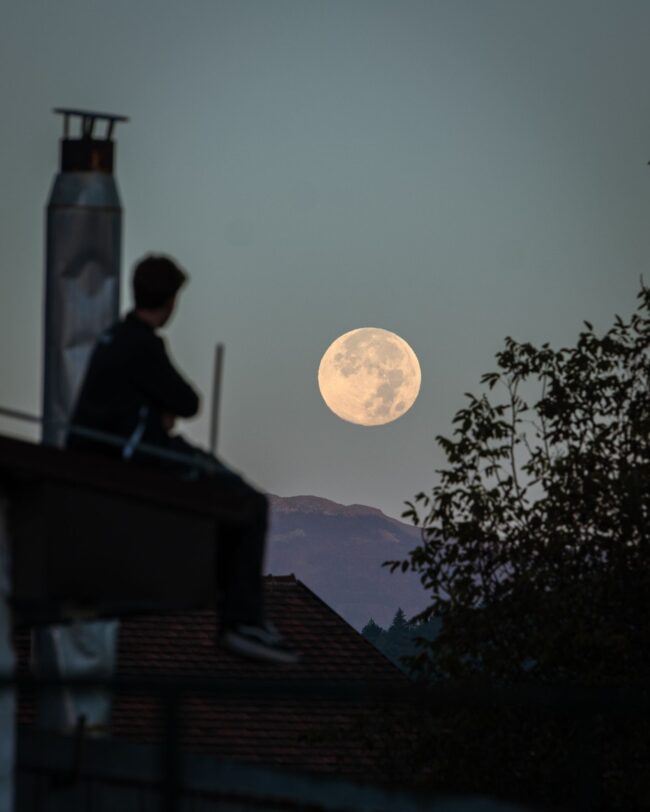
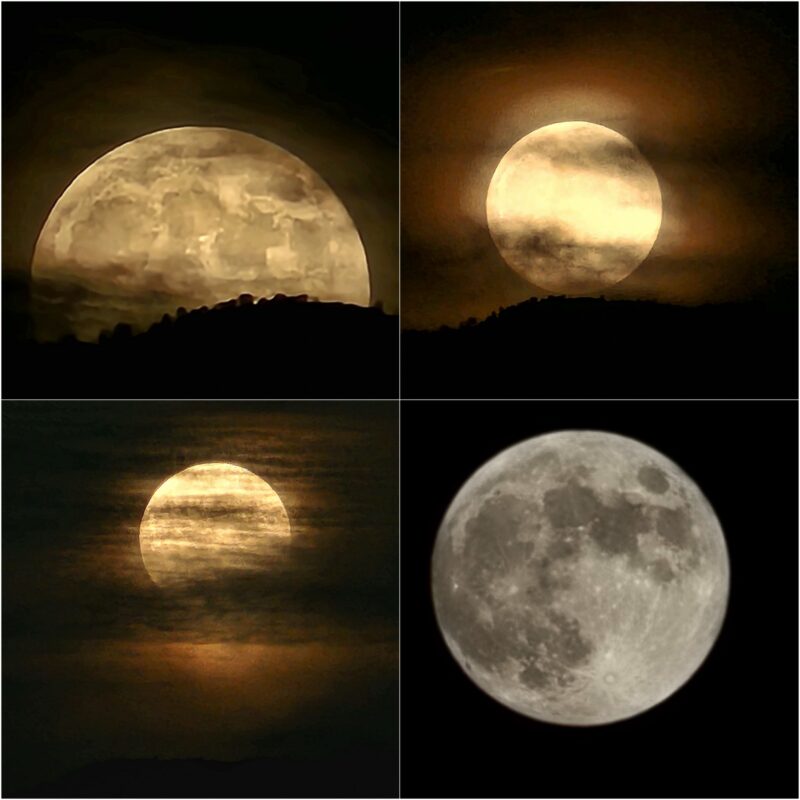
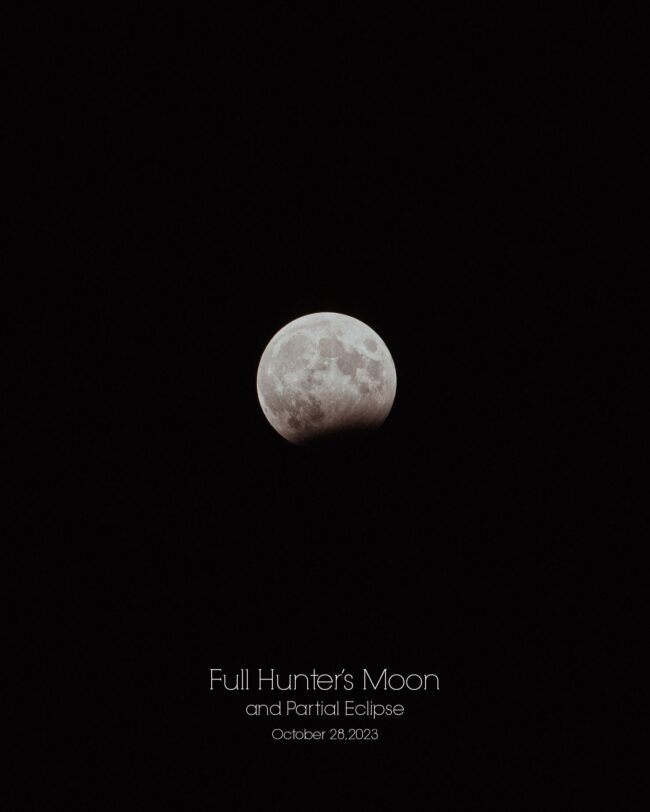
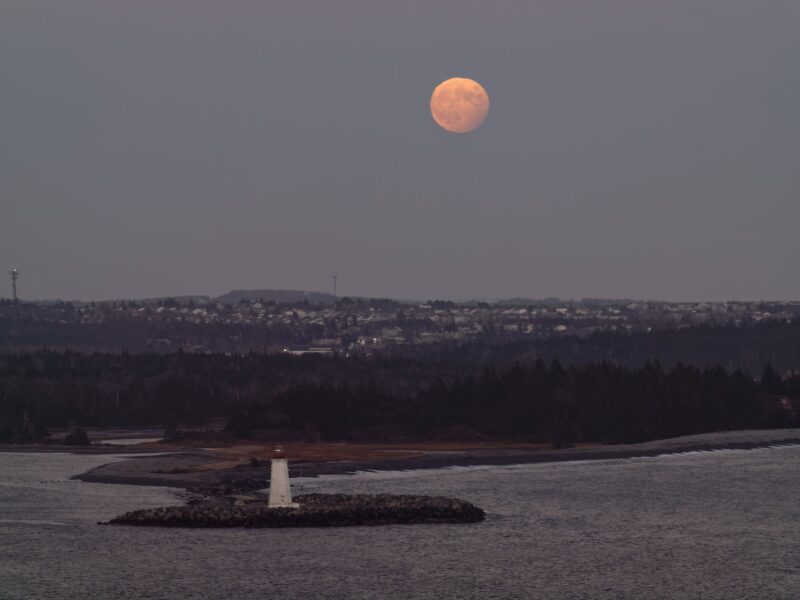
Bottom line: The Super Hunter’s Moon – this year’s October full moon – is on October 17, 2024. Plus, it’s the closest – and brightest – supermoon of 2024.
The post Super Hunter’s Moon: Closest supermoon in 2024 first appeared on EarthSky.
from EarthSky https://ift.tt/H3EyXDc

It’s a full moon, the Hunter’s Moon and the closest supermoon of 2024.
Super Hunter’s Moon follows the Super Harvest Moon
When and where to look in 2024: For all of us on Earth, the bright, round full moon will rise in the east around sunset on October 17, 2024. It’ll be visible all night. Be sure to watch on the nights before and after that, too. This is the Northern Hemisphere’s Hunter’s Moon, the full moon after the Harvest Moon (which is the full moon closest to the autumnal equinox). This Hunter’s Moon is also the third of four supermoons in a row in 2024.
The crest of the full moon falls that morning for the Americas at 11:26 UTC on October 17. That’s 6:26 a.m. CDT, about two hours before moonset in central North America. If you want to see the fullest possible moon, look in the west on the morning of October 17 before sunrise.
The moon’s perigee, or closest point to Earth for this month, falls about 10 hours before the crest of the moon’s full phase. Perigee comes at 8 p.m. CDT on October 16 (1 UTC on October 17). So this is a very close full moon, known as a supermoon. In fact, it’s the closest supermoon of 2024! So it’ll be the brightest moon of this year.
Characteristics of the Hunter’s Moon: The moon is always roundest on the day that it’s full. And, on the day of a full moon, the moon always rises close to the time of sunset. But the nights before and after a full moon feature a round-looking moon, too. And, like the Harvest Moon, this October Hunter’s moon will be characterized by a shorter-than-usual time between successive moonrises for several nights in a row. So Northern Hemisphere dwellers will see full-looking moons in twilight skies, ascending in the east as the sun sets in the west, for several nights around October 17.
For the Southern Hemisphere, the nights around this full moon feature a longer-than-usual time between successive moonrises. So, for the southern part of the globe, the moon will rise on October 18, 19 and 20 (and for many nights after that) in a sky that’s already dark.

What’s special about a Hunter’s Moon?
A full moon is always opposite the sun in space, and opposite the sun in our sky. So all full moons rise in the east around sunset. And all full moons set in the west around sunrise. But the various full moons have different characteristics.
On average, the moon rises about 50 minutes later each day. But when a full moon happens close to the autumnal equinox – either a Harvest or a Hunter’s Moon – the moon (at mid-temperate latitudes) rises only about 30 to 35 minutes later daily for several days before and after the full moon. The reason is that the ecliptic – which more or less marks the path the moon travels across the sky – makes a narrow angle with the evening horizon around the time of the autumnal equinox.
The result is that there’s a shorter-than-usual lag time between successive moonrises around the full Hunter’s Moon.
Early evening moonrises make every Hunter’s Moon special. Every full moon rises around sunset. After the full Hunter’s Moon, you’ll see the moon ascending in the east relatively soon after sunset for a few days in a row at northerly latitudes.
A great source of moonrise times is the Custom Sunrise Sunset Calendar. Once you get to that page, be sure to click the box for “moon phases” and “moonrise and moonset times.”
By the way, since the Harvest Moon is the closest full moon to the equinox, it can come either before or after it. So the Harvest Moon can sometimes fall in October, which it does every three or four years. When the Harvest Moon falls in October, the Hunter’s Moon – the full moon following the Harvest Moon – will fall in early November.
That’ll happen next in 2025.

A word about supermoons
A full supermoon happens when the full moon happens at – or near – the time the moon is closest to us in its elliptical orbit.
Of course, full supermoons draw a lot of attention and are very popular.
Do supermoons look bigger to the eye? Generally not, unless you’re an avid moon observer. But … do supermoons look brighter than ordinary full moons? Yes! By a noticeable amount. That’s because a supermoon exceeds the disk size of an average-sized moon by up to 8% and the brightness of an average-sized full moon by some 16%. And then, it exceeds the disk size of a micro-moon (a year’s most distant and therefore smallest full moon) up to 14% and the brightness of a micro-moon by some 30%. So, go outside on the night of a full supermoon. Even if you’re a casual observer of the moon, there’s a chance you’ll notice the supermoon is exceptionally bright!
A note to those in the Southern Hemisphere
If you’re in the Southern Hemisphere, your Harvest and Hunter’s Moons center on the March equinox, your autumnal equinox. Much of what we say in his post – the general information about Harvest and Hunter’s Moons – applies to you, too… next March and April.
Right now, your full moon will be doing the opposite of a Hunter’s Moon. That is, for the Southern Hemisphere around the time of the September and October full moons, there’s a longer-than-usual time between moonrises on successive nights.

Tips and tricks to view the Super Hunter’s Moon
How did the Hunter’s Moon get its name?
There are many stories surrounding the names of the moons, including the Hunter’s Moon. From a practical standpoint, the Harvest Moon and subsequent Hunter’s Moon provided extra light in the evenings for farmers and hunters to finish their tasks.
Every full moon has a slew of nicknames tied to months of the year. But some moon names, such as the Harvest and Hunter’s Moons, are tied to seasons.
In North America, the Harvest Moon was a time when the bright moon meant farmers could stay out later, working in their fields, gathering in the crops before the first freeze. After the harvest, farmers would turn to hunting deer and other animals to bolster their food stores before winter. The bright light of the full moon and almost full moons would let them hunt into the evening hours. So, we call it a Hunter’s Moon.
Who named the Harvest and Hunter’s Moon? Those names probably sprang to the lips of farmers and hunters throughout the Northern Hemisphere, on autumn evenings, at times of the full moon.
Is a Hunter’s Moon bigger or brighter?
Generally, no. The Hunter’s Moon is just an ordinary full moon with a special path across our sky. Still, many of us do think the Hunter’s Moon looks bigger … or brighter … and more orange than usual. Why?
It’s because the Hunter’s Moon has a powerful mystique. Many people look for it shortly after sunset around the time of full moon. After sunset around any full moon, the moon will always be near the horizon … because full moons rise at sunset. It’s the location of the moon near the horizon that causes the Hunter’s Moon – or any full moon – to look big and orange in color.
The orange color of a moon near the horizon is a true physical effect. It stems from the fact that, when you look toward the horizon, you’re looking through a greater thickness of Earth’s atmosphere than when you gaze up and overhead. The atmosphere scatters blue light – that’s why the sky looks blue. The greater thickness of atmosphere in the direction of a horizon scatters blue light most effectively, but it lets red light pass through to your eyes. So a full moon near the horizon – any full moon near the horizon – takes on a yellow or orange or reddish hue.
The bigger-than-usual size of a moon seen near the horizon is something else entirely. It’s a trick that your eyes are playing – an illusion – called the Moon Illusion.
However, in 2024, the Hunter’s Moon is a supermoon. And it’s the closest supermoon in 2024. So yes, it will look brighter than an average full moon!
2024 full moon is in Pisces
The October full moon usually lies in front of one of three constellations of the zodiac: Pisces the Fish, Aries the Ram, or Cetus the Whale.
Typically, it’s in Pisces and that is the case for 2024.

Hunter’s Moon photos from our community




Bottom line: The Super Hunter’s Moon – this year’s October full moon – is on October 17, 2024. Plus, it’s the closest – and brightest – supermoon of 2024.
The post Super Hunter’s Moon: Closest supermoon in 2024 first appeared on EarthSky.
from EarthSky https://ift.tt/H3EyXDc

Aucun commentaire:
Enregistrer un commentaire